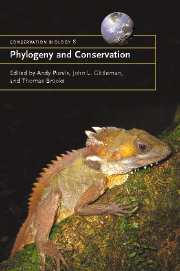Book contents
- Frontmatter
- Contents
- List of contributors
- 1 Phylogeny and conservation
- Part 1 Units and currencies
- Part 2 Inferring evolutionary processes
- 7 Age and area revisited: identifying global patterns and implications for conservation
- 8 Putting process on the map: why ecotones are important for preserving biodiversity
- 9 The oldest rainforests in Africa: stability or resilience for survival and diversity?
- 10 Late Tertiary and Quaternary climate change and centres of endemism in the southern African flora
- 11 Historical biogeography, diversity and conservation of Australia's tropical rainforest herpetofauna
- Part 3 Effects of human processes
- Part 4 Prognosis
- Index
- References
11 - Historical biogeography, diversity and conservation of Australia's tropical rainforest herpetofauna
Published online by Cambridge University Press: 04 December 2009
- Frontmatter
- Contents
- List of contributors
- 1 Phylogeny and conservation
- Part 1 Units and currencies
- Part 2 Inferring evolutionary processes
- 7 Age and area revisited: identifying global patterns and implications for conservation
- 8 Putting process on the map: why ecotones are important for preserving biodiversity
- 9 The oldest rainforests in Africa: stability or resilience for survival and diversity?
- 10 Late Tertiary and Quaternary climate change and centres of endemism in the southern African flora
- 11 Historical biogeography, diversity and conservation of Australia's tropical rainforest herpetofauna
- Part 3 Effects of human processes
- Part 4 Prognosis
- Index
- References
Summary
INTRODUCTION
Faced with a combination of increasing degradation of habitats and sparse knowledge of species and their distributions, biologists are struggling to find ways of predicting spatial patterns of diversity and then to devise effective strategies for conservation. Area-based conservation planning typically applies complementarity algorithms to identify one or more combinations of areas that effectively represent the known pattern of species diversity (Margules & Pressey 2000). Usually, high-quality distribution data are available for only a limited number of taxonomic groups (e.g. trees, birds, butterflies), so geographic patterns of diversity in these groups must act as a ‘surrogate’ for those of other taxa. Even this level of knowledge may be lacking for some areas, or at finer spatial scales, leading to the use of environmental (e.g. climate, soil, etc.) data in addition to, or in place of, species' occurrence information (Ferrier 2002; see also Faith et al. 2001). The efficiency of such surrogates appears to vary, especially at the finer spatial scales relevant to most conservation planning efforts (see, for example, van Jaarsveld et al. 1998; Moritz et al. 2001; Lund & Rahbeck 2002).
Even where the geographic pattern of species diversity is known or can be predicted from other taxa, species-based conservation plans may be ineffective at capturing genetic diversity within and across species (Crozier 1997; Moritz 2002). In this context, attention has been given to using evolutionary trees to estimate the phylogenetic diversity (PD) (Faith 1992) represented by a given set of species or areas.
- Type
- Chapter
- Information
- Phylogeny and Conservation , pp. 243 - 264Publisher: Cambridge University PressPrint publication year: 2005
References
- 12
- Cited by



